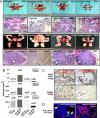Targeting the stromal androgen receptor in primary prostate tumors at earlier stages
- PMID: 18723670
- PMCID: PMC2527887
- DOI: 10.1073/pnas.0804701105
Targeting the stromal androgen receptor in primary prostate tumors at earlier stages
Abstract
To differentiate roles of androgen receptor (AR) in prostate stromal and epithelial cells, we have generated inducible-(ind)ARKO-TRAMP and prostate epithelial-specific ARKO TRAMP (pes-ARKO-TRAMP) mouse models, in which the AR was knocked down in both prostate epithelium and stroma or was knocked out in the prostate epithelium, respectively. We found that loss of AR in both mouse models resulted in poorly differentiated primary tumors with expanded intermediate cell populations. Interestingly, knockdown of both epithelial and stromal AR in ind-ARKO-TRAMP mice at earlier stages resulted in smaller primary prostate tumors with lower proliferation rates, and knockout of AR in pes-ARKO-TRAMP mice resulted in larger primary prostate tumors with higher proliferation rates. The differential proliferation rates, yet with similarly expanded intermediate cell populations, indicated that the prostate stromal AR might play a more dominant role than the epithelial AR to promote primary tumor proliferation at an early stage of tumor. Tissue recombination of human prostate stromal cell lines (WPMY1-v or WPMY1-ARsi) with human prostate cancer epithelial cell lines (PC3-v or PC3-AR9) further demonstrated that the AR might function as a suppressor in epithelial cells and a proliferator in stromal cells in the primary prostate tumors. The dual roles of the AR in prostate epithelium and stroma may require us to reevaluate the target and timing of androgen-deprivation therapy for prostate cancer patients and may suggest a need to develop new drugs to selectively target stromal AR in the primary prostate tumors at earlier stages.
Conflict of interest statement
The authors declare no conflict of interest.
Figures





References
-
- Cunha GR. Epithelial-stromal interactions in development of the urogenital tract. Int Rev Cytol. 1976;47:137–194. - PubMed
-
- Heinlein CA, Chang C. Androgen receptor in prostate cancer. Endocr Rev. 2004;25:276–308. - PubMed
-
- Cunha GR, Chung LW. Stromal-epithelial interactions–I. Induction of prostatic phenotype in urothelium of testicular feminized (Tfm/y) mice. J Steroid Biochem. 1981;14:1317–1324. - PubMed
-
- Donjacour AA, Cunha GR. The effect of androgen deprivation on branching morphogenesis in the mouse prostate. Dev Biol. 1988;128:1–14. - PubMed
-
- Hayward SW, et al. Interactions between adult human prostatic epithelium and rat urogenital sinus mesenchyme in a tissue recombination model. Differentiation. 1998;63:131–140. - PubMed
Publication types
MeSH terms
Substances
Grants and funding
LinkOut - more resources
Full Text Sources
Other Literature Sources
Medical
Molecular Biology Databases
Research Materials

